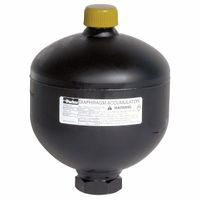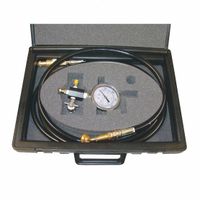Call +(254) 703 030 000 / 751 483 999 / 721 704 777
- Home
- Hydraulics
- Hydraulic Accumulators
.....Read More
Frequently Asked Questions
What is a hydraulic accumulator and how does it work?
A hydraulic accumulator is a device used in hydraulic systems to store pressurized hydraulic fluid. Its primary function is to maintain system pressure, absorb shocks, and provide a quick burst of fluid power when needed. It works by compressing a gas (typically nitrogen) within a sealed chamber. When the system pressure increases, hydraulic fluid is pushed into the accumulator, compressing the gas. When the system pressure drops, the compressed gas expands, pushing the stored fluid back into the system. This action helps to smooth out pressure fluctuations, compensate for fluid leakage, and provide auxiliary power, making hydraulic systems more efficient and stable. There are several types of accumulators, including bladder, diaphragm, and piston accumulators, each suited for different applications and operating conditions.
What are the different types of hydraulic accumulators?
Please specify what topic you would like me to elaborate on.
How do you select the right hydraulic accumulator for a specific application?
Selecting the right hydraulic accumulator involves considering several crucial factors to ensure optimal system performance and longevity. First, determine the accumulator's primary function: energy storage, pulsation dampening, shock absorption, or leakage compensation. This dictates the required volume and response characteristics.
Next, evaluate the system's operating pressure and temperature. The accumulator's maximum working pressure must exceed the system's peak pressure, and its material must withstand the operating temperature range.
Consider the fluid compatibility. The accumulator's bladder or diaphragm material must be compatible with the hydraulic fluid to prevent degradation and ensure reliable operation.
Calculate the required accumulator volume. This depends on the fluid volume to be absorbed or released, the pressure differential, and the gas pre-charge pressure. Various formulas and charts are available for this calculation, often based on Boyle's Law for gas accumulators.
Finally, assess mounting constraints and environmental conditions. Space availability, vibration, and extreme temperatures can influence the choice between piston, bladder, or diaphragm accumulators and their construction. Consulting with a hydraulic accumulator manufacturer or an experienced engineer is recommended for complex applications to ensure the safest and most efficient choice.
What are the advantages and disadvantages of diaphragm, bladder, and piston accumulators?
Diaphragm accumulators are compact and lightweight, making them suitable for applications with limited space. They offer good response times and are less susceptible to contamination due to their sealed design. However, they have a smaller gas volume compared to other types, limiting their energy storage capacity, and are not ideal for high-pressure applications.
Bladder accumulators provide a clear separation between the gas and fluid, preventing gas dissolution and contamination. They offer high fluid discharge rates and are suitable for a wide range of pressures. Their bladders can be replaced, extending their service life. On the downside, bladder accumulators can be sensitive to rapid pressure fluctuations, and the bladder material may degrade over time, leading to leakage.
Piston accumulators are robust and durable, capable of handling high pressures and large fluid volumes. They offer precise control over fluid discharge and are less prone to leakage due to their sturdy construction. They are often used in heavy-duty applications. However, piston accumulators are generally larger and heavier than diaphragm or bladder types, requiring more installation space. They can also experience friction between the piston and cylinder walls, potentially leading to wear and heat generation.
How do you charge a hydraulic accumulator?
Charging a hydraulic accumulator involves pressurizing the gas chamber (typically nitrogen) to a specific pre-charge pressure, which depends on the system's operating pressure and the type of accumulator. This is usually done using a charging kit, which includes a nitrogen cylinder, a charging hose with a pressure gauge, and a charging valve that connects to the accumulator.
First, ensure the hydraulic system is depressurized and isolated. Connect the charging hose to the accumulator's gas valve and the nitrogen cylinder. Slowly open the nitrogen cylinder valve and carefully monitor the pressure gauge on the charging kit. Charge the accumulator to the desired pre-charge pressure, ensuring not to overfill. Once the correct pressure is reached, close the nitrogen cylinder valve, then close the accumulator's gas valve, and finally disconnect the charging kit. It's crucial to consult the manufacturer's guidelines for the specific accumulator and system for the precise pre-charge pressure and charging procedure. Regular checks of the pre-charge pressure are also essential for optimal system performance and safety.
What maintenance is required for hydraulic accumulators?
Hydraulic accumulators require regular maintenance to ensure their optimal performance and longevity. Key maintenance tasks include checking the gas pre-charge pressure, as this is crucial for the accumulator's function and can change over time due to temperature fluctuations or minor leaks. The fluid level and quality in the hydraulic system should also be monitored, as contamination or low levels can impact the accumulator. Visual inspections for external damage, corrosion, or leaks on the accumulator body, connections, and mounting brackets are essential. Any signs of wear or damage should be addressed promptly. Depending on the type of accumulator, internal components like bladders or diaphragms may need periodic inspection or replacement to prevent system failures. It's also important to verify the proper functioning of safety devices, such as pressure relief valves. Adhering to the manufacturer's recommended maintenance schedule and using appropriate tools and procedures are vital for safe and efficient operation.
How do you troubleshoot common issues with hydraulic accumulators?
Troubleshooting common issues with hydraulic accumulators involves addressing problems like pressure loss, fluid contamination, and seal failures. For pressure loss, check for external leaks in the accumulator or connecting lines, and verify the gas pre-charge pressure. If the pre-charge is too low, recharge the accumulator to the manufacturer's specifications. For fluid contamination, inspect the hydraulic fluid for debris or discoloration. If contaminated, drain and replace the fluid, and consider adding a filter to the system. Seal failures can lead to external leaks or internal bypass. To diagnose, visually inspect seals for wear or damage, and if necessary, replace the seal kit according to the manufacturer's guidelines. Always depressurize the system and follow safety procedures before performing any maintenance on hydraulic accumulators. Regular maintenance and adherence to manufacturer recommendations are crucial for preventing these issues.
What safety precautions should be taken when working with hydraulic accumulators?
Working with hydraulic accumulators requires strict adherence to safety precautions due to the high pressures involved. Before any work begins, always ensure the system is depressurized and locked out to prevent accidental energy release. This typically involves closing isolation valves, bleeding off pressure, and verifying zero pressure with a gauge. Never attempt to dismantle or service an accumulator until all stored energy has been safely discharged.
Personal protective equipment (PPE) is crucial. This includes safety glasses or a face shield, gloves, and appropriate protective clothing to guard against hydraulic fluid injection injuries, which can be severe. Always inspect accumulators for visible damage, leaks, or corrosion before use.
When charging or recharging accumulators, use the correct charging kit and follow the manufacturer's specified procedures and pressure ratings. Overcharging can lead to catastrophic failure. Ensure the charging gas (usually nitrogen) is handled safely, and never use oxygen or shop air, as this can create an explosive mixture.
During maintenance or installation, secure the accumulator properly to prevent it from falling or rolling. Be aware of the weight and potential hazards associated with handling these components. After any work, thoroughly test the system for leaks and proper operation before returning it to service. Regular inspection and maintenance by qualified personnel are essential to ensure the continued safe operation of hydraulic accumulators.
How do hydraulic accumulator safety blocks function?
Hydraulic accumulator safety blocks are crucial components in hydraulic systems that utilize accumulators. Their primary function is to safely isolate the accumulator from the rest of the hydraulic circuit, allowing for maintenance, repair, or system depressurization without the risk of stored energy being inadvertently released.
These blocks typically incorporate a manually operated or pilot-operated valve that can be closed to cut off the flow of hydraulic fluid to and from the accumulator. This isolation prevents the high-pressure gas charge within the accumulator from discharging into the system when it's not desired, such as during a shutdown or when working on downstream components.
In addition to isolation, many safety blocks also include a pressure relief valve and a pressure gauge. The pressure relief valve acts as a safety measure to prevent over-pressurization of the accumulator itself, discharging fluid if the internal pressure exceeds a safe limit. The pressure gauge allows operators to monitor the pressure within the accumulator, ensuring it's at the correct operating level or completely depressurized before maintenance.
By combining these features, hydraulic accumulator safety blocks provide a critical layer of safety, protecting personnel and preventing damage to equipment by managing the potentially dangerous stored energy of the accumulator. They ensure that work can be performed on the hydraulic system in a controlled and safe manner.
What are the typical applications of hydraulic accumulators in industrial systems?
Hydraulic accumulators are essential components in many industrial systems, serving various crucial applications. One primary use is energy storage, where they absorb excess fluid volume and pressure during low-demand periods and release it during high-demand cycles, optimizing pump efficiency and reducing power consumption. This "peak shaving" capability helps to smooth out system demands and prevent pump oversizing.
Another significant application is pulsation dampening. Accumulators can effectively absorb pressure surges and pulsations generated by pumps or sudden valve closures, protecting system components from damage and ensuring smoother operation. This is particularly vital in systems with high-pressure fluctuations or long pipelines.
They are also used for emergency power and safety. In the event of a power failure or pump malfunction, accumulators can provide a temporary source of hydraulic power to operate critical functions, such as opening or closing safety valves, extending landing gear, or performing emergency shutdowns, ensuring system integrity and personnel safety.
Furthermore, accumulators facilitate volume compensation by absorbing fluid expansion or contraction due to temperature changes, maintaining a stable system pressure and preventing overpressure or cavitation. This is common in closed-loop systems or those exposed to varying ambient temperatures.
Finally, they can be employed for shock absorption, mitigating hydraulic shocks caused by sudden changes in flow direction or load, thus protecting sensitive equipment and extending the lifespan of the entire hydraulic system.




